“”The Indians have a tradition concerning a strange, serpent-like creature inhabiting the waters of Bear Lake, which they say carried off some of their braves many moons ago. Since then, they willnot sleep close to the lake. Neither will they swim in it, nor let their squaws nor papooses bathe in it.
Now, it seems this water devil, as the Indians called it, has again made an appearance. A number of our white settlers declare they have seen it with their own eyes. This Bear Lake Monster, they now call it, is causing a great deal of excitement up here. S.M. Johnson, at South Eden, was riding along near the lake the other day when he saw something a number of yards out in the lake which he thought was the body of a man. 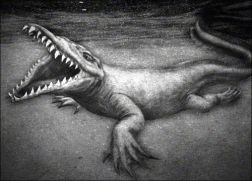 He waited for the waves to wash it in, but to his surprise, found the water washed over it without causing it to move. Then he saw it had a head and neck like some strange animal. On each side of the head were ears, or bunches the size of a pint cup. He concluded the body must be touching the bottom of the lake. By this time, however, Johnson seems to have been leaving the place so rapidly he failed to observe other details.
He waited for the waves to wash it in, but to his surprise, found the water washed over it without causing it to move. Then he saw it had a head and neck like some strange animal. On each side of the head were ears, or bunches the size of a pint cup. He concluded the body must be touching the bottom of the lake. By this time, however, Johnson seems to have been leaving the place so rapidly he failed to observe other details.
The next day three women and a man saw a monstrous animal in the lake near the same place, but this time it was swimming at an incredible speed. According to their statement, it was moving faster than a horse could run.”
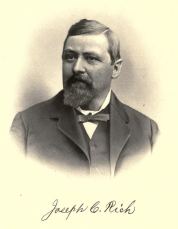 This was the second-hand account of a mythical lake creature, as reported by Joseph C. Rich, a Mormon colonizer, and published in The Deseret Evening News in the year 1868. The article created quite a stir in Salt Lake City, so much that L.D.S. Church leader, Brigham Young, visited the area to investigate. L.D.S. Leaders dialogued with Charles C. Rich
This was the second-hand account of a mythical lake creature, as reported by Joseph C. Rich, a Mormon colonizer, and published in The Deseret Evening News in the year 1868. The article created quite a stir in Salt Lake City, so much that L.D.S. Church leader, Brigham Young, visited the area to investigate. L.D.S. Leaders dialogued with Charles C. Rich and other settlers from The Bear Lake Valley, regarding the lake monster. Considering the testimony that had been given “by so many individuals, who have seen a creature in so many places and under a variety of circumstances,” they considered the story to be “indisputable.” Brigham Young went so far as sending a large rope to Paris, Idaho to aid in capturing the monster.
and other settlers from The Bear Lake Valley, regarding the lake monster. Considering the testimony that had been given “by so many individuals, who have seen a creature in so many places and under a variety of circumstances,” they considered the story to be “indisputable.” Brigham Young went so far as sending a large rope to Paris, Idaho to aid in capturing the monster.
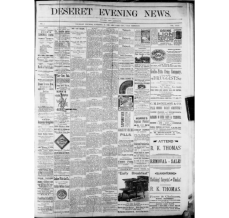 The Deseret News continued to publish articles about the monster—waffling back and forth, first as a skeptic, and then defending its existence. The Salt Lake Tribune wrote that the monster was the “twin brother to the devil and a cousin to Brigham Young.”
The Deseret News continued to publish articles about the monster—waffling back and forth, first as a skeptic, and then defending its existence. The Salt Lake Tribune wrote that the monster was the “twin brother to the devil and a cousin to Brigham Young.”
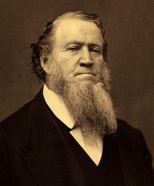 Young wasn’t the only person interested in capturing the creature. A local resident proposed using a large, baited hook attached to a twenty-foot cable and three hundred yards of one-inch rope, at the end of which was a large buoy with a flagstaff inserted, and an anchor to keep it in a perpendicular position. From the buoy, one hundred yards of three-quarter-inch rope was to be extended to a tree on shore. (Wow…I wonder if that resident went on to design the game, “Mouse Trap” or something…) If captured, the community felt the monster could serve as freak show type competition to the famous traveling circus of P.T. Barnum.
Young wasn’t the only person interested in capturing the creature. A local resident proposed using a large, baited hook attached to a twenty-foot cable and three hundred yards of one-inch rope, at the end of which was a large buoy with a flagstaff inserted, and an anchor to keep it in a perpendicular position. From the buoy, one hundred yards of three-quarter-inch rope was to be extended to a tree on shore. (Wow…I wonder if that resident went on to design the game, “Mouse Trap” or something…) If captured, the community felt the monster could serve as freak show type competition to the famous traveling circus of P.T. Barnum.
 What does the Bear Lake Monster look like? The descriptions vary:
What does the Bear Lake Monster look like? The descriptions vary:
• Its size was reported anywhere from 40 to 200 feet long.
• Its head was described as that of a cow, a walrus without tusks, or like that of an alligator.
• It’s eyes were very large and wide apart.
• It had a large undulating serpent like body with about 30 feet of exposed surface at each sighting.
• It was cream colored early on and somehow morphed into a dark, slimy green at last sighting.
• It had ears about the size of a pint cup.
• Although it had an unknown number of legs, their length was firmly established at eighteen inches long, Although walking on land was difficult for the beast, it was quite speedy in water.
• There are claims of the monster swimming faster than a horse could run on dry land, or even faster than a locomotive (New name for the beast! Clark Kent, aka the SuperMANster!) reaching speeds of 60 m.p.h.
• Some sightings even spoke of a second member of the species and smaller monsters as well.
Articles about the Bear Lake Monster continued to appear, either reciting new sightings of the creature(s) in Bear Lake and spreading to sightings at outlying rivers and lakes in the Utah Territory, or calling the sightings into question. The number of appearances of lake monsters across northern Utah caused some people to speculate that there was an underground channel connecting the Great Salt Lake and other waterways to Bear Lake. (An underground snailroad for sea creatures?)
As interest died down about the monster, twenty-six years following his first article and allegations, Joseph C. Rich finally admitted that it had all been a “wonderful first class lie.”
 The Bear Lake Monster appears in Animal Planet’s “Lost Tapes,” drama series, in which it is depicted as similar to a crocodile or a mosasaur. The show portrays a group of girls who were attacked by the monster while staying in tents beside the lake.
The Bear Lake Monster appears in Animal Planet’s “Lost Tapes,” drama series, in which it is depicted as similar to a crocodile or a mosasaur. The show portrays a group of girls who were attacked by the monster while staying in tents beside the lake.
Most recently the search for this creature was the subject of SyFy Channel’s Haunted Highway Season 1, Episode 1 (2012) “Bear Lake Beast; vs Hairy Man.” In this show the investigators found a cow bone in a submerged cave, leading to the question: How did it get there?

Bear Lake Monster? Or Muskrat? You decide.
Since its first reported sighting in 1868, the Bear Lake Monster has become a part of folklore and a source of pride for the locals. In more recent years it has become a tourist attraction of sorts as the legend of the Bear Lake Monster has prompted an influx of tourists hoping to catch a view of the lake beast.
 A 1907 letter published in a Logan, Utah newspaper claimed that two men had seen the Bear Lake behemoth attack their camp and kill one of their horses.
A 1907 letter published in a Logan, Utah newspaper claimed that two men had seen the Bear Lake behemoth attack their camp and kill one of their horses.
A man spotted the monster early one evening as he was walking along the lake. He tried to shoot it with his rifle. The man was a crack shot, but not one of his bullets touched that monster. It scared the heck out of him and he high tailed it home faster than you can say Jack Robinson. He left his rifle behind, claiming the monster ate it.
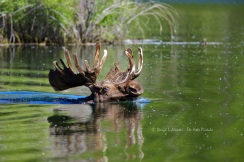
Yep! Yep! Thar she blows!!
My father, David Jasper Kearl III, shared a story with me recently about the monster. It was 1930-31 and he was all of 4-5 years old at the time. He recalls the excitement in town as members of the community came running up from the lake claiming that the monster had surfaced. The entire population of Laketown converged at the water’s edge in anticipation of spotting the mythical beast. It ended up being a rather large, swimming moose.
A four-year-old claimed to see it in 1937
A Boy Scout leader spoke of seeing it in 1946.
The last reported sighting of the monster was in June 2002. Brian Hirschi announced that he had seen the creature, but skeptics were quick to point out that his story hit the newspapers on Memorial Day weekend — the start of the summer Bear Lake tourist season.
It happened, he insists, one night in June 2002 as he was anchoring his large pontoon tour boat — ironically shaped like a sea monster — after a day of ferrying tourists around the 20-mile long, 8-mile wide and 208-foot deep crystal blue lake.
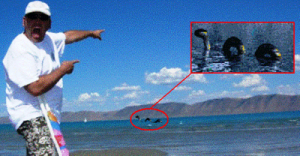 After anchoring his vessel, he saw “two humps in the water” about 100 yards from the boat. At first, he thought they were water skis, but they disappeared. Then, his boat lifted up. “The next thing I know, a serpent-like creature shot up out of the water.” He said it had “really dark, slimy green skin and deep beet-red eyes.” It sunk back down under the water as quickly as it arose, but not before making a sound like a roaring bull.
After anchoring his vessel, he saw “two humps in the water” about 100 yards from the boat. At first, he thought they were water skis, but they disappeared. Then, his boat lifted up. “The next thing I know, a serpent-like creature shot up out of the water.” He said it had “really dark, slimy green skin and deep beet-red eyes.” It sunk back down under the water as quickly as it arose, but not before making a sound like a roaring bull.
Hirschi feared everyone would think he was crazy or out on the lake too much. But a year after his experience, he chose to break his silence.
 To scoffers who claim his revelation was nothing more than a publicity stunt to boost the Bear Lake tourist trade, he replies: “Once you’ve seen the monster, you really don’t care what other people say.”
To scoffers who claim his revelation was nothing more than a publicity stunt to boost the Bear Lake tourist trade, he replies: “Once you’ve seen the monster, you really don’t care what other people say.”
For years, Hirschi’s Bear Lake Monster Boat offered a 45-minute scenic cruise of Bear Lake with folklore storytelling. During the  Raspberry Days parade, there have been float entries manned by local children, labeled “The REAL Bear Lake Monsters.”
Raspberry Days parade, there have been float entries manned by local children, labeled “The REAL Bear Lake Monsters.”
With the monster being quiet for the last little bit, people have started to say it is gone for good. What they don’t know is that while tag teaming the tethering of some skinned sticks in preparation for erecting a Tipi at last year’s BEAR LAKE RENDEZVOUS, Fuzzy and Kash were playing a lively game of “I Spy” when the monster surfaced again.
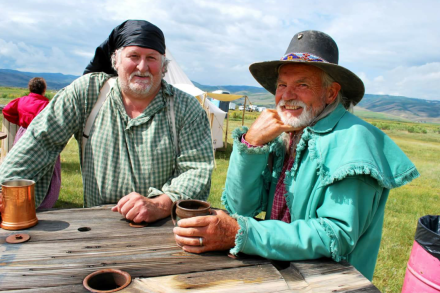
“I spy a lake monster!” Fuzzy shouted. “Yeah, right,” Kash played along. “No! Really!” Fuzzy exclaimed. Being skilled trappers, one with imposing size and the other quick reflexes, Kash and Fuzzy took on the beast. The resulting skirmish went on for days, stirring numerous micro bursts around Bear Lake as the monster tried to drown the Mountain Men by blowing lake water from its tuba horn sized nostrils. (Remember how rainy the Rendezvous was last year? Well, it all makes sense now, doesn’t it…) Kash flung the monster by its tail to Fuzzy, who whipped the demon seed above and around his head so fast and high that it sailed halfway around the world, landing in Scotland’s Loch Ness. Mountain Men are known for their tall tales and this one seems mighty steep, but I do have it on good authority that CLARK KENT, THE SUPERMANSTER is making his way back home, via that watery, secret UNDERGROUND SNAILROAD, seeking what is sure to be a tale (yes, I meant tale, not tail) whipping, ginormous rematch with our fearless Members of the Board at the Rendezvous come August!
 So, when you travel to Bear Lake for the 2015 BEAR LAKE RENDEZVOUS, if you look long enough and hard enough, you just might catch a glimpse of the beast emerging from its exile. Aim your eyes on the lake at dusk. Don’t even blink! And don’t say I didn’t warn you about swimming in Bear Lake after the sun goes down…
So, when you travel to Bear Lake for the 2015 BEAR LAKE RENDEZVOUS, if you look long enough and hard enough, you just might catch a glimpse of the beast emerging from its exile. Aim your eyes on the lake at dusk. Don’t even blink! And don’t say I didn’t warn you about swimming in Bear Lake after the sun goes down…
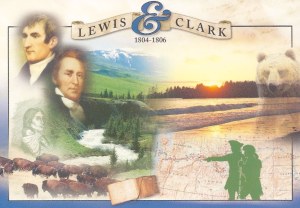 Watkuweis was single-handedly responsible for saving The Lewis and Clark Expedition, although they never even knew.
Watkuweis was single-handedly responsible for saving The Lewis and Clark Expedition, although they never even knew. The story of Watkuweis has been handed down in the oral history of the Nez Perce tribe. Lewis and Clark never even knew, so of course they recorded nothing of the event. Clark did meet her and recorded in his journal about the woman who had been captured by the Minitarries of the North and had seen white men.
The story of Watkuweis has been handed down in the oral history of the Nez Perce tribe. Lewis and Clark never even knew, so of course they recorded nothing of the event. Clark did meet her and recorded in his journal about the woman who had been captured by the Minitarries of the North and had seen white men. 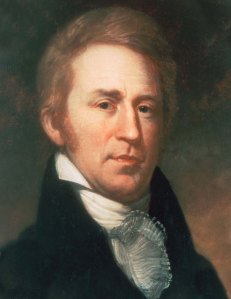
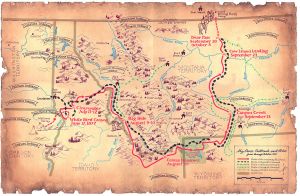
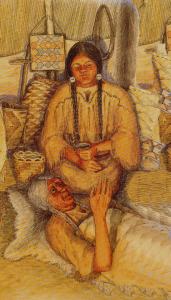 She was on her deathbed when the strange party of white men arrived with their Shoshone guide. Their arrival immediately aroused suspicion because the Nez Perce had recently sent a group of their men to try and establish peace with the Shoshones, but the Nez Perce delegation was killed. They felt vulnerable, since many Nez Perce warriors were absent from the village at this time, having gone to revenge their fallen tribes.
She was on her deathbed when the strange party of white men arrived with their Shoshone guide. Their arrival immediately aroused suspicion because the Nez Perce had recently sent a group of their men to try and establish peace with the Shoshones, but the Nez Perce delegation was killed. They felt vulnerable, since many Nez Perce warriors were absent from the village at this time, having gone to revenge their fallen tribes.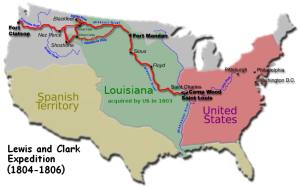

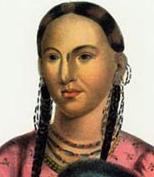 You know of Sacajewea, but have you heard of Marie Dorion? She was the second woman to make the long trip from Missouri to the West Coast. She was in her early 20’s at the time her husband, Pierre Dorion, was hired as a guide and interpreter for the Wilson Hunt Party of 1811. Marie, along with her two children, Baptiste (approx. age 4) and Paul (approx. age 2), were brought along.
You know of Sacajewea, but have you heard of Marie Dorion? She was the second woman to make the long trip from Missouri to the West Coast. She was in her early 20’s at the time her husband, Pierre Dorion, was hired as a guide and interpreter for the Wilson Hunt Party of 1811. Marie, along with her two children, Baptiste (approx. age 4) and Paul (approx. age 2), were brought along.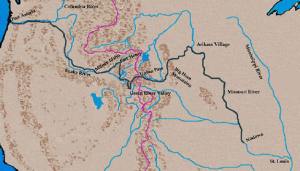
 Marie caught two horses and hoisted the wounded LeClerc over one saddle, along with what supplies she could hastily pack. With her two children on the other horse, she forged her way back to the main cabin.
Marie caught two horses and hoisted the wounded LeClerc over one saddle, along with what supplies she could hastily pack. With her two children on the other horse, she forged her way back to the main cabin.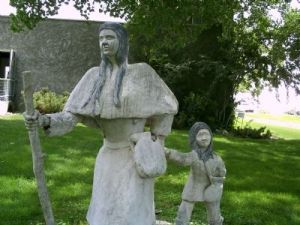
 Finally, she reached the Wallah Wallah River and then traveled for 15 more days to reach the Columbia River Plains. Weak from hunger, and barely able to walk, she saw smoke in the distance. Leaving her children lying under a Buffalo robe, she walked, and then crawled, to reach that distant camp. It turned out to be friendly Wallah Wallah Indians, who tracked back to rescue her two children.
Finally, she reached the Wallah Wallah River and then traveled for 15 more days to reach the Columbia River Plains. Weak from hunger, and barely able to walk, she saw smoke in the distance. Leaving her children lying under a Buffalo robe, she walked, and then crawled, to reach that distant camp. It turned out to be friendly Wallah Wallah Indians, who tracked back to rescue her two children. On April 17th, canoes from Fort Astoria, approaching the mouth of the Wallah Wallah, were intercepted by this tribe. When they pulled to shore they were amazed to hear of Marie Dorion’s story of survival under such hardship!
On April 17th, canoes from Fort Astoria, approaching the mouth of the Wallah Wallah, were intercepted by this tribe. When they pulled to shore they were amazed to hear of Marie Dorion’s story of survival under such hardship! Used with permission from The Women of The Fur Trade and with special thanks to Sandy Gabbert Hunt, who did a 5 day trip down The Snake River, in a bull boat, on the 200th anniversary of Marie Dorion’s trek!
Used with permission from The Women of The Fur Trade and with special thanks to Sandy Gabbert Hunt, who did a 5 day trip down The Snake River, in a bull boat, on the 200th anniversary of Marie Dorion’s trek!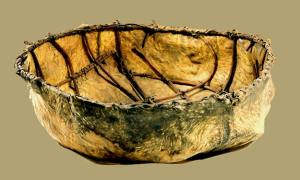

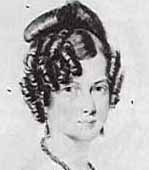 Women of European descent were known as “Tender Exotics” and were almost unknown in the fur trade, with many developing mental health issues and returning to the motherland or eastern cities. Most of the problems encountered by these women had their roots in the class-conscious nature of British society of the time. The wife of a fur company manager was expected to associate only with other women of her class. In the remote posts, there would be no-one else at that level, and it wasn’t proper or allowable for her to associate with Indian or mixed-heritage women, even if, by some remote chance, there wasn’t a language barrier. As a manager’s wife, servants took care of the domestic tasks about the house. Thus, she felt very little purpose, with the exception of being there for her husband, who was gone, sometimes, for several months at a time. Wilderness conditions and societal demands created a “rock and a hard place” environment in which “Tender Exotics” lost their will.
Women of European descent were known as “Tender Exotics” and were almost unknown in the fur trade, with many developing mental health issues and returning to the motherland or eastern cities. Most of the problems encountered by these women had their roots in the class-conscious nature of British society of the time. The wife of a fur company manager was expected to associate only with other women of her class. In the remote posts, there would be no-one else at that level, and it wasn’t proper or allowable for her to associate with Indian or mixed-heritage women, even if, by some remote chance, there wasn’t a language barrier. As a manager’s wife, servants took care of the domestic tasks about the house. Thus, she felt very little purpose, with the exception of being there for her husband, who was gone, sometimes, for several months at a time. Wilderness conditions and societal demands created a “rock and a hard place” environment in which “Tender Exotics” lost their will.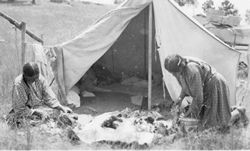 On the northern plains and Rocky Mountain regions, the role of the Indian women, in the affairs of the tribe, was as the authority in domestic matters, with primary responsibilities for housekeeping. From the European perspective this role, in many ways, had a greater resemblance to slave than partner. The women were responsible for child rearing, cooking, butchering, preparing hides, skins, and robes, gathering firewood, preserving foods, all aspects of agriculture (if any) making and mending clothing and moccasins, constructing the lodge and most aspects of establishing and raising camp. Tanning and preparing buffalo robes was very labor intensive, and an ambitious man wishing to increase his wealth might have multiple wives to increase robe production.
On the northern plains and Rocky Mountain regions, the role of the Indian women, in the affairs of the tribe, was as the authority in domestic matters, with primary responsibilities for housekeeping. From the European perspective this role, in many ways, had a greater resemblance to slave than partner. The women were responsible for child rearing, cooking, butchering, preparing hides, skins, and robes, gathering firewood, preserving foods, all aspects of agriculture (if any) making and mending clothing and moccasins, constructing the lodge and most aspects of establishing and raising camp. Tanning and preparing buffalo robes was very labor intensive, and an ambitious man wishing to increase his wealth might have multiple wives to increase robe production.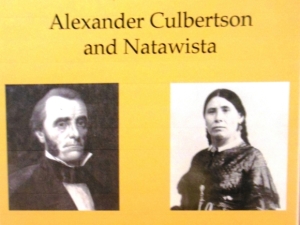 To become the wife of a fur trader, the Indian woman was offered the prospect of an alternate way of life that was often easier physically and richer in material ways. Such an alliance did require some sacrifice in personal autonomy as the Indian woman was forced to make some adjustments to the traders patriarchal views of home and family. One Nor’Wester noted that Cree women considered it an honor to be selected as wives by the voyageurs.
To become the wife of a fur trader, the Indian woman was offered the prospect of an alternate way of life that was often easier physically and richer in material ways. Such an alliance did require some sacrifice in personal autonomy as the Indian woman was forced to make some adjustments to the traders patriarchal views of home and family. One Nor’Wester noted that Cree women considered it an honor to be selected as wives by the voyageurs.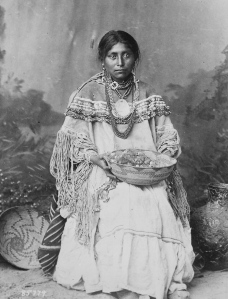 An Indian woman, who married a trapper/trader, might remain with her village where he would visit her periodically, or she might live at the fort/post with her trader husband, or accompany the nomadic wanderings of her trapper husband. It is said that the only authority that the Free Trapper would acknowledge was that of his Indian spouse. This authority was asserted as much with a white spouse as well as with a man of her own tribe. The household was effectively the property of the woman, and to a certain extent the products of her labor were hers to dispose of as she wished. In some aspects the Indian woman enjoyed considerably more autonomy than her European counterpart, at times leading to considerable confusion amongst the patriarchal trader/trappers.
An Indian woman, who married a trapper/trader, might remain with her village where he would visit her periodically, or she might live at the fort/post with her trader husband, or accompany the nomadic wanderings of her trapper husband. It is said that the only authority that the Free Trapper would acknowledge was that of his Indian spouse. This authority was asserted as much with a white spouse as well as with a man of her own tribe. The household was effectively the property of the woman, and to a certain extent the products of her labor were hers to dispose of as she wished. In some aspects the Indian woman enjoyed considerably more autonomy than her European counterpart, at times leading to considerable confusion amongst the patriarchal trader/trappers.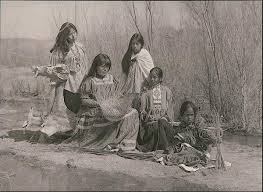


 Trappers, who chose to raise mixed blood families, often found themselves acting as mediators between the two cultures, interpreting each to the other and many would even find themselves aligned with their adopted people in times of conflict. Women and children often traveled with the trapping brigades. If it was not possible to travel with their husbands, the women might return to their tribal families, or might camp near the trading post until their husbands returned from the hunt.
Trappers, who chose to raise mixed blood families, often found themselves acting as mediators between the two cultures, interpreting each to the other and many would even find themselves aligned with their adopted people in times of conflict. Women and children often traveled with the trapping brigades. If it was not possible to travel with their husbands, the women might return to their tribal families, or might camp near the trading post until their husbands returned from the hunt.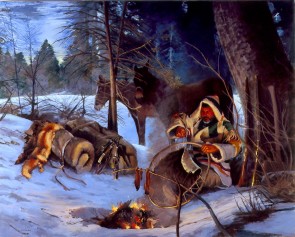
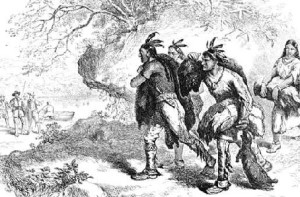

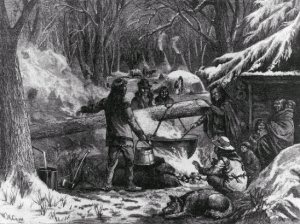

 He waited for the waves to wash it in, but to his surprise, found the water washed over it without causing it to move. Then he saw it had a head and neck like some strange animal. On each side of the head were ears, or bunches the size of a pint cup. He concluded the body must be touching the bottom of the lake. By this time, however, Johnson seems to have been leaving the place so rapidly he failed to observe other details.
He waited for the waves to wash it in, but to his surprise, found the water washed over it without causing it to move. Then he saw it had a head and neck like some strange animal. On each side of the head were ears, or bunches the size of a pint cup. He concluded the body must be touching the bottom of the lake. By this time, however, Johnson seems to have been leaving the place so rapidly he failed to observe other details. This was the second-hand account of a mythical lake creature, as reported by Joseph C. Rich, a Mormon colonizer, and published in The Deseret Evening News in the year 1868. The article created quite a stir in Salt Lake City, so much that L.D.S. Church leader, Brigham Young, visited the area to investigate. L.D.S. Leaders dialogued with Charles C. Rich
This was the second-hand account of a mythical lake creature, as reported by Joseph C. Rich, a Mormon colonizer, and published in The Deseret Evening News in the year 1868. The article created quite a stir in Salt Lake City, so much that L.D.S. Church leader, Brigham Young, visited the area to investigate. L.D.S. Leaders dialogued with Charles C. Rich
 The Deseret News continued to publish articles about the monster—waffling back and forth, first as a skeptic, and then defending its existence. The Salt Lake Tribune wrote that the monster was the “twin brother to the devil and a cousin to Brigham Young.”
The Deseret News continued to publish articles about the monster—waffling back and forth, first as a skeptic, and then defending its existence. The Salt Lake Tribune wrote that the monster was the “twin brother to the devil and a cousin to Brigham Young.”
 What does the Bear Lake Monster look like? The descriptions vary:
What does the Bear Lake Monster look like? The descriptions vary:
 The Bear Lake Monster appears in Animal Planet’s “Lost Tapes,” drama series, in which it is depicted as similar to a crocodile or a mosasaur. The show portrays a group of girls who were attacked by the monster while staying in tents beside the lake.
The Bear Lake Monster appears in Animal Planet’s “Lost Tapes,” drama series, in which it is depicted as similar to a crocodile or a mosasaur. The show portrays a group of girls who were attacked by the monster while staying in tents beside the lake.
 A 1907 letter published in a Logan, Utah newspaper claimed that two men had seen the Bear Lake behemoth attack their camp and kill one of their horses.
A 1907 letter published in a Logan, Utah newspaper claimed that two men had seen the Bear Lake behemoth attack their camp and kill one of their horses.

 To scoffers who claim his revelation was nothing more than a publicity stunt to boost the Bear Lake tourist trade, he replies: “Once you’ve seen the monster, you really don’t care what other people say.”
To scoffers who claim his revelation was nothing more than a publicity stunt to boost the Bear Lake tourist trade, he replies: “Once you’ve seen the monster, you really don’t care what other people say.” Raspberry Days parade, there have been float entries manned by local children, labeled “The REAL Bear Lake Monsters.”
Raspberry Days parade, there have been float entries manned by local children, labeled “The REAL Bear Lake Monsters.”

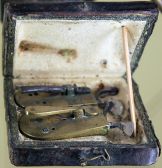 There were three main therapeutic principles for treatment of disease:
There were three main therapeutic principles for treatment of disease:
 Their letters always began and usually ended with assurances of the good health of the letter writer, a query about the health of the recipient, and a wish for continuing good health for all.
Their letters always began and usually ended with assurances of the good health of the letter writer, a query about the health of the recipient, and a wish for continuing good health for all. Quacks and charlatans practiced virtually unchecked. Distrust of physicians ran high during these times, and often those afflicted with illness would attempt their own treatments
Quacks and charlatans practiced virtually unchecked. Distrust of physicians ran high during these times, and often those afflicted with illness would attempt their own treatments  through folk medicine or Indian remedies before resorting to “professional care.”
through folk medicine or Indian remedies before resorting to “professional care.”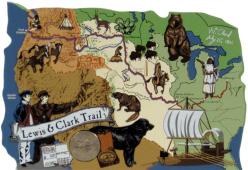 The list below provides the content of The Lewis and Clark Expedition’s medicine chest:
The list below provides the content of The Lewis and Clark Expedition’s medicine chest: Tucked away in the fertile Cache Valley of northern Utah, and less than an hour away from The Bear Lake Rendezvous, lies the agricultural college community of Logan. It was here that trappers scurried through the surrounding mountains and valleys hunting beaver and other fur-bearing animals. They “cached” their pelts in secretive locations then “cashed” in their bootie at the yearly “Vous.”
Tucked away in the fertile Cache Valley of northern Utah, and less than an hour away from The Bear Lake Rendezvous, lies the agricultural college community of Logan. It was here that trappers scurried through the surrounding mountains and valleys hunting beaver and other fur-bearing animals. They “cached” their pelts in secretive locations then “cashed” in their bootie at the yearly “Vous.”

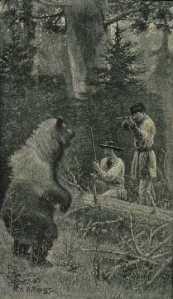 rushing upon them at a furious rate. They immediately sprang to their rifles which were standing against a tree hard-by, one of which was single and the other double triggered; unfortunately in the hurry, the one that was accustomed to the single trigger, caught up the double triggered gun, and when the bear came upon him, not having set the trigger, he could not get his gun off; and the animal approaching within a few feet of him, he was obliged to commence beating it over the head with his gun.
rushing upon them at a furious rate. They immediately sprang to their rifles which were standing against a tree hard-by, one of which was single and the other double triggered; unfortunately in the hurry, the one that was accustomed to the single trigger, caught up the double triggered gun, and when the bear came upon him, not having set the trigger, he could not get his gun off; and the animal approaching within a few feet of him, he was obliged to commence beating it over the head with his gun. 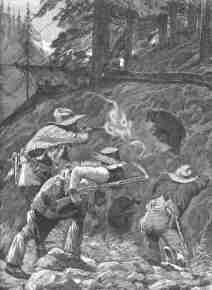
 The following is an account of an encounter Captain Jedediah Smith, also with a grizzly bear.
The following is an account of an encounter Captain Jedediah Smith, also with a grizzly bear.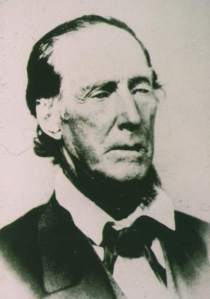 Clyman, the second in command, checked the Captain over. Old Ephraim had broken several of his ribs. He had gotten Jedediah’s head into his mouth. The left eye was gashed. His skull near the crown was stripped bare. The right ear was hanging by a thread. Everyone stood around as Clyman asked Smith what should be done. The Captain said, “One or two go for water. Get a needle and thread and sew up the wounds around my head.
Clyman, the second in command, checked the Captain over. Old Ephraim had broken several of his ribs. He had gotten Jedediah’s head into his mouth. The left eye was gashed. His skull near the crown was stripped bare. The right ear was hanging by a thread. Everyone stood around as Clyman asked Smith what should be done. The Captain said, “One or two go for water. Get a needle and thread and sew up the wounds around my head. “Old Ephraim” is the Mountain Man name for Grizzly Bear. The bear who truly owned the name was an infamous 1,100 pound beast, also known as “Old Three Toes.” The nickname was given by sheephearders due to a deformity on one foot of the grizzly. Old Ephraim had a hearty appetite for sheep, cattle, and big game and was the last grizzly bear known to roam Utah. His reign was from 1911 until his death on August 22, 1923.
“Old Ephraim” is the Mountain Man name for Grizzly Bear. The bear who truly owned the name was an infamous 1,100 pound beast, also known as “Old Three Toes.” The nickname was given by sheephearders due to a deformity on one foot of the grizzly. Old Ephraim had a hearty appetite for sheep, cattle, and big game and was the last grizzly bear known to roam Utah. His reign was from 1911 until his death on August 22, 1923. Frank Clark shot Old Ephraim in the head on 8/22/1923 with a .25-35 carbine rifle. It reportedly took all seven rounds to kill the bear. At the time of his death, Old Ephraim stood 10 feet (3.0 m) tall.
Frank Clark shot Old Ephraim in the head on 8/22/1923 with a .25-35 carbine rifle. It reportedly took all seven rounds to kill the bear. At the time of his death, Old Ephraim stood 10 feet (3.0 m) tall. 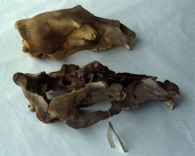
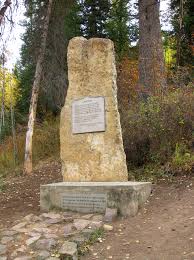 Boy Scouts placed a pile of stones over the bear’s remains. Later, an 11-foot tall stone monument, designed by Max Arthur and Howard Jorgensen, was placed at the grave site. This memorial was dedicated on 9/23/1996. Two plaques were placed. One was a poem that reads: “Old Ephraim, Old Ephraim, Your deeds were so wrong yet we build you this marker and sing you this song. To the king of the forest so mighty and tall, we salute you, old Ephraim the king of them all.”
Boy Scouts placed a pile of stones over the bear’s remains. Later, an 11-foot tall stone monument, designed by Max Arthur and Howard Jorgensen, was placed at the grave site. This memorial was dedicated on 9/23/1996. Two plaques were placed. One was a poem that reads: “Old Ephraim, Old Ephraim, Your deeds were so wrong yet we build you this marker and sing you this song. To the king of the forest so mighty and tall, we salute you, old Ephraim the king of them all.” The ride to Old Ephraim’s grave is a 20-mile loop rolling through the northern Wasatch Range, following dirt roads, jeep roads, and a touch of singletrack for bikers. The loop commences with several miles of moderate climbing up Cowley Canyon, followed by more climbing, at times rough and steep, to the upper trailhead for Ricks Canyon.
The ride to Old Ephraim’s grave is a 20-mile loop rolling through the northern Wasatch Range, following dirt roads, jeep roads, and a touch of singletrack for bikers. The loop commences with several miles of moderate climbing up Cowley Canyon, followed by more climbing, at times rough and steep, to the upper trailhead for Ricks Canyon.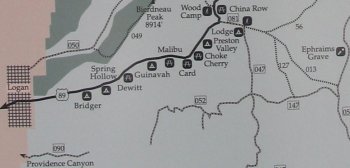
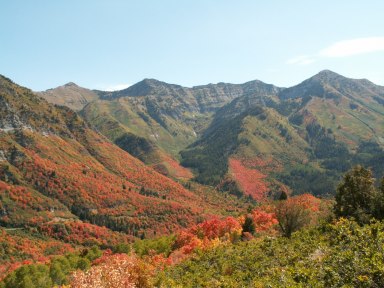
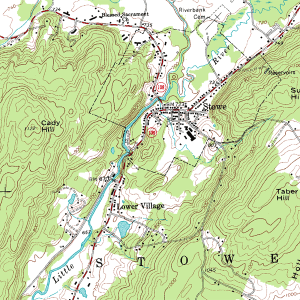
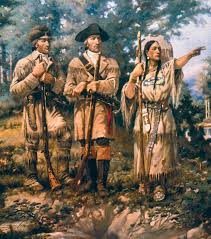 These fur traders were either accompanied by Native Americans, or Native Americans told them about the major passes and routes through the Rocky Mountains.
These fur traders were either accompanied by Native Americans, or Native Americans told them about the major passes and routes through the Rocky Mountains.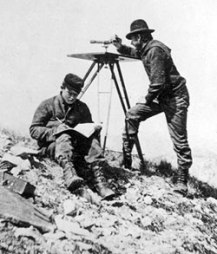 The French explorers who mapped the shores of America’s Great Lakes were not trained in surveying. When we look at the maps they drew, in the 1600s and 1700s, there are many mistakes. Modern surveying had to wait, in any case, until the invention of a reliable chronometer watch that could be used to observe astronomical objects and precisely fix longitudes. The inventor who assembled the first longitudinal chronometer was an Englishman, a Mr. John Harrison, and he and his successors sold chronometers to the “sea dogs” of the Royal Navy.
The French explorers who mapped the shores of America’s Great Lakes were not trained in surveying. When we look at the maps they drew, in the 1600s and 1700s, there are many mistakes. Modern surveying had to wait, in any case, until the invention of a reliable chronometer watch that could be used to observe astronomical objects and precisely fix longitudes. The inventor who assembled the first longitudinal chronometer was an Englishman, a Mr. John Harrison, and he and his successors sold chronometers to the “sea dogs” of the Royal Navy.  Starting in the late 1700s, the Royal Navy calibrated its chronometers by the longitude of its headquarters in Greenwich, a suburb of London, and the longitudinal numbers that flash on our GPS devices are based upon Greenwich to this day. Determining one’s precise location, which now can be done with the push of a button or two on a smart phone, then required tedious observations of several known angles – such as the elevation of the North Star – and then complex arithmetical calculations by the light of a grimy window, a candle, or an oil lamp.
Starting in the late 1700s, the Royal Navy calibrated its chronometers by the longitude of its headquarters in Greenwich, a suburb of London, and the longitudinal numbers that flash on our GPS devices are based upon Greenwich to this day. Determining one’s precise location, which now can be done with the push of a button or two on a smart phone, then required tedious observations of several known angles – such as the elevation of the North Star – and then complex arithmetical calculations by the light of a grimy window, a candle, or an oil lamp.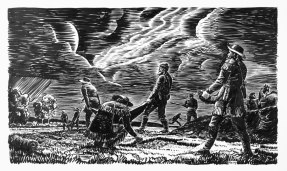
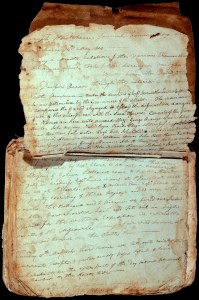
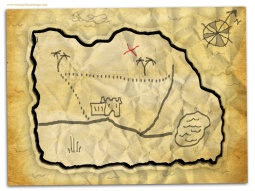 and to find it they made rough maps, identifying a large mound of dirt over here…a unique tree over there…a big boulder…They would then note the location of the cache by pacing the distance to the cache from each identified landmark.
and to find it they made rough maps, identifying a large mound of dirt over here…a unique tree over there…a big boulder…They would then note the location of the cache by pacing the distance to the cache from each identified landmark.
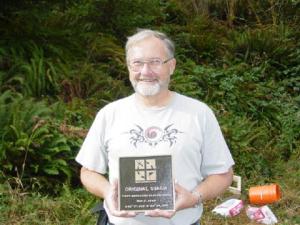




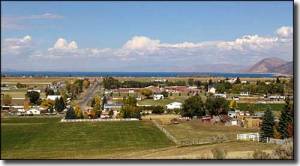
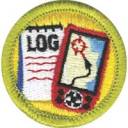 If you are bringing your family up to camp and visit the Rendezvous, consider giving geocaching a go. If you have a boy scout in your family, they can earn a merit badge for participating. This is a FUN, FUN activity for the entire family!
If you are bringing your family up to camp and visit the Rendezvous, consider giving geocaching a go. If you have a boy scout in your family, they can earn a merit badge for participating. This is a FUN, FUN activity for the entire family!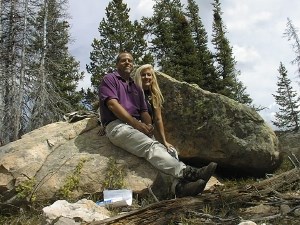

 Covington relates that William Sublette arrived in Lexington on September 15, 1827 with a train of pack mules, laden with beaver, to meet William Ashley’s party from St. Louis, who had several wagon loads of goods and groceries ready for transport. Sublette advertised for new recruits and Covington, along with several of his bachelor friends, answered the call. In exchange for $250.00, the men agreed to dedicate 12-14 months to pack goods and trap beaver. The men purchased from the company, at what Covington called “very low” prices, two blankets, a capote, two heavy red flannel shirts, and as much extra clothing as each thought proper to lay in. Most also purchased two pounds of tobacco and a pound of salt. On or around October 1, 1827, Jackson and Sublette took charge of the pack train and, with 45 men – Covington included – and 80 mules heavily loaded with good and groceries, they headed to the mountains with goods and supplies valued at $20,000.00.
Covington relates that William Sublette arrived in Lexington on September 15, 1827 with a train of pack mules, laden with beaver, to meet William Ashley’s party from St. Louis, who had several wagon loads of goods and groceries ready for transport. Sublette advertised for new recruits and Covington, along with several of his bachelor friends, answered the call. In exchange for $250.00, the men agreed to dedicate 12-14 months to pack goods and trap beaver. The men purchased from the company, at what Covington called “very low” prices, two blankets, a capote, two heavy red flannel shirts, and as much extra clothing as each thought proper to lay in. Most also purchased two pounds of tobacco and a pound of salt. On or around October 1, 1827, Jackson and Sublette took charge of the pack train and, with 45 men – Covington included – and 80 mules heavily loaded with good and groceries, they headed to the mountains with goods and supplies valued at $20,000.00. It was a brutally cold winter that year and by the time they reached the mountains the mules were starving and freezing. Every night one or more mule died until every man was on foot. There was no place to cache goods, so the men were forced to carry the merchandise. Just before Christmas, in the Black Hills near where Fort Laramie is now located, they stopped in a cottonwood grove and made camp. On Christmas morning Sublette distributed pure brandy which was well received by the company after such hard traveling.
It was a brutally cold winter that year and by the time they reached the mountains the mules were starving and freezing. Every night one or more mule died until every man was on foot. There was no place to cache goods, so the men were forced to carry the merchandise. Just before Christmas, in the Black Hills near where Fort Laramie is now located, they stopped in a cottonwood grove and made camp. On Christmas morning Sublette distributed pure brandy which was well received by the company after such hard traveling. Covington reports that during this time, the principal food of these trappers was beaver meat. This contradicts long-held beliefs of many historians who claim the mountain men seldom ate the meat of the beaver they trapped.
Covington reports that during this time, the principal food of these trappers was beaver meat. This contradicts long-held beliefs of many historians who claim the mountain men seldom ate the meat of the beaver they trapped. During the spring, blowing snow and rain caused considerable damage to one of the caches. Several bales of calico, red and blue cloths, tobacco, sugar, coffee and raisins became wet and damaged. Entire bolts of cloth had to be opened and spread out to dry.
During the spring, blowing snow and rain caused considerable damage to one of the caches. Several bales of calico, red and blue cloths, tobacco, sugar, coffee and raisins became wet and damaged. Entire bolts of cloth had to be opened and spread out to dry.


 We camped at the south end of the lake. It had a most beautiful shore, sloping gradually to the water’s edge, sandy and gravelly, with a considerable quantity of cottonwood trees growing without any underbrush. South of the lake was a beautiful a valley as eyes ever beheld, about two or three miles each way, all covered with the most luxuriant grass, which furnished excellent pasturage for our animals. About half a mile from the lake, a large spring came up out of the prairie, which made a stream about two feet deep and fifteen or twenty feet wide, with plenty of the finest quality of fish. This was on the east, and on the west, not more than half a mile, came out another spring of nearly the same description, both boiling up on the prairie, and dry ground all round. Both of these streams ran down a gradual slope into the lake.”
We camped at the south end of the lake. It had a most beautiful shore, sloping gradually to the water’s edge, sandy and gravelly, with a considerable quantity of cottonwood trees growing without any underbrush. South of the lake was a beautiful a valley as eyes ever beheld, about two or three miles each way, all covered with the most luxuriant grass, which furnished excellent pasturage for our animals. About half a mile from the lake, a large spring came up out of the prairie, which made a stream about two feet deep and fifteen or twenty feet wide, with plenty of the finest quality of fish. This was on the east, and on the west, not more than half a mile, came out another spring of nearly the same description, both boiling up on the prairie, and dry ground all round. Both of these streams ran down a gradual slope into the lake.”
 Rendezvous this year would last through the early part of July. Covington describes a lively time at rendezvous. “Plenty of fine horses; plenty of fine brandy and whiskey at $2.00 a pint or tin cup full; plenty of goods and groceries of almost every description. Horse racing and shooting was carried on to a considerable degree, while card playing and drinking was not neglected.” Like so many rendezvous yet to come, the men let their hair down and celebrated another successful year in the Rocky Mountains.
Rendezvous this year would last through the early part of July. Covington describes a lively time at rendezvous. “Plenty of fine horses; plenty of fine brandy and whiskey at $2.00 a pint or tin cup full; plenty of goods and groceries of almost every description. Horse racing and shooting was carried on to a considerable degree, while card playing and drinking was not neglected.” Like so many rendezvous yet to come, the men let their hair down and celebrated another successful year in the Rocky Mountains. Many of the most famous of mountaineers were present. Hugh Glass retold the famous story of his encounter with a grizzly and even pulled off his shirt to show the scars on his back and body as proof. Covington mentions becoming acquainted with Jim Bridger, Ezekiel Abels, Jim Beckwourth and Black Harris. Harris is believed to have gone west with Sublette in 1827. His whereabouts were unknown up until 1829, but it is now apparent that Harris was at Bear Lake in the summer of 1828.
Many of the most famous of mountaineers were present. Hugh Glass retold the famous story of his encounter with a grizzly and even pulled off his shirt to show the scars on his back and body as proof. Covington mentions becoming acquainted with Jim Bridger, Ezekiel Abels, Jim Beckwourth and Black Harris. Harris is believed to have gone west with Sublette in 1827. His whereabouts were unknown up until 1829, but it is now apparent that Harris was at Bear Lake in the summer of 1828. Supplied by John Jacob Astor’s American Fur Company and to add a little competition, Joshua Pilcher’s fur company was also present at the 1828 rendezvous. Most of their supplies, which had been cached, were destroyed by water seepage. They were, however, successful in trading for 17 packs of beaver with the meager supplies that they were able to salvage. Many historians link Johnson Gardner to Pilcher, claiming Gardner acted as Pilcher’s clerk, but he did not hire on with Pilcher until after the end of the rendezvous. Covington’s dialogue indicated Gardner was a free trapper, who had the best rifle in the company short of Captain Sublette. Gardner must have accompanied the furs east, then hired on with Sublette’s supply train.
Supplied by John Jacob Astor’s American Fur Company and to add a little competition, Joshua Pilcher’s fur company was also present at the 1828 rendezvous. Most of their supplies, which had been cached, were destroyed by water seepage. They were, however, successful in trading for 17 packs of beaver with the meager supplies that they were able to salvage. Many historians link Johnson Gardner to Pilcher, claiming Gardner acted as Pilcher’s clerk, but he did not hire on with Pilcher until after the end of the rendezvous. Covington’s dialogue indicated Gardner was a free trapper, who had the best rifle in the company short of Captain Sublette. Gardner must have accompanied the furs east, then hired on with Sublette’s supply train. The partners of Smith, Jackson and Sublette were responsible for the task of returning furs themselves to St. Louis. The company made their departure from rendezvous for St. Louis around the fifteenth of August, with 45 to 50 men and about 80 or 90 mules heavily laden with fur valued at nearly $36,000.00, consisting of 7710 pounds of Beaver pelts, 59 otter skins, 73 muskrat skins and 27 pounds of castoreum.
The partners of Smith, Jackson and Sublette were responsible for the task of returning furs themselves to St. Louis. The company made their departure from rendezvous for St. Louis around the fifteenth of August, with 45 to 50 men and about 80 or 90 mules heavily laden with fur valued at nearly $36,000.00, consisting of 7710 pounds of Beaver pelts, 59 otter skins, 73 muskrat skins and 27 pounds of castoreum. 
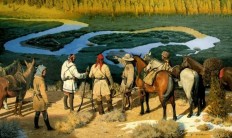
 On the Platte River Plains the company was surprised to spot several hundred Indians riding toward them at full speed. The men halted, formed a circle, unpacked the goods and piled them up for breast works. The mules were then picketed within the perimeter and the men hunkered down behind the packs, rifles aimed and ready, but the Indians proved to be Pawnee merely looking for buffalo. A few tobacco plugs earned the company passage.
On the Platte River Plains the company was surprised to spot several hundred Indians riding toward them at full speed. The men halted, formed a circle, unpacked the goods and piled them up for breast works. The mules were then picketed within the perimeter and the men hunkered down behind the packs, rifles aimed and ready, but the Indians proved to be Pawnee merely looking for buffalo. A few tobacco plugs earned the company passage. Jackson and Sublette arrived in St Louis on October 13, 1828, netting a surplus of $16,000.00. Upon their arrival, the men of the party all stood in front of Ashley’s fine home and unpacked the mules. General Ashley, his wife, and his sister-in-law hosted the company for a breakfast of coffee, tea, white biscuits, and good butter. Nearly all of the men were still attired in suits of leather, hunting shirts, and blanket coats – just as they came off the plains. Says Covington, they had not washed with soap for months!
Jackson and Sublette arrived in St Louis on October 13, 1828, netting a surplus of $16,000.00. Upon their arrival, the men of the party all stood in front of Ashley’s fine home and unpacked the mules. General Ashley, his wife, and his sister-in-law hosted the company for a breakfast of coffee, tea, white biscuits, and good butter. Nearly all of the men were still attired in suits of leather, hunting shirts, and blanket coats – just as they came off the plains. Says Covington, they had not washed with soap for months!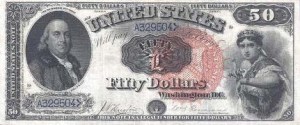
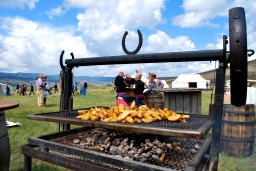

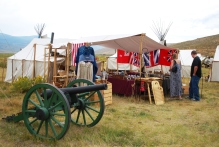 Those already pre-registered traders, who were contacted about the possibility of this change, do not need to resubmit registration. We will update our forms and flyers, and contact all other websites that may be advertising the now incorrect dates.
Those already pre-registered traders, who were contacted about the possibility of this change, do not need to resubmit registration. We will update our forms and flyers, and contact all other websites that may be advertising the now incorrect dates. 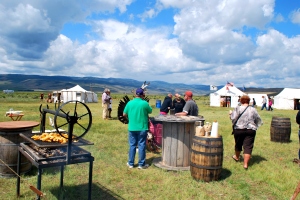
 William Ashley hired Hiram Scott and 46-60 men to take the supply caravan to the 1827 rendezvous. The caravan left St. Louis on April 12, 1827.
William Ashley hired Hiram Scott and 46-60 men to take the supply caravan to the 1827 rendezvous. The caravan left St. Louis on April 12, 1827.
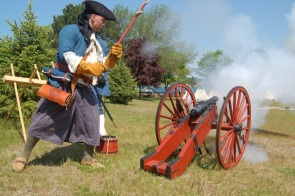 A four-pounder cannon, the first wheeled vehicle ever taken into the mountains, was part of this caravan. The route traversed the Platte River, then along the North Platte River and finally across South Pass – the eastern part of the Oregon Trail.
A four-pounder cannon, the first wheeled vehicle ever taken into the mountains, was part of this caravan. The route traversed the Platte River, then along the North Platte River and finally across South Pass – the eastern part of the Oregon Trail.  It is thought the group arrived in late June. They were definitely on site by July 3rd, greeted by Mountain Men and Native Americans already gathering in anticipation of the rendezvous at the south end of Sweet (Bear) Lake. At the time, this rendezvous was within the territory of Mexico.
It is thought the group arrived in late June. They were definitely on site by July 3rd, greeted by Mountain Men and Native Americans already gathering in anticipation of the rendezvous at the south end of Sweet (Bear) Lake. At the time, this rendezvous was within the territory of Mexico.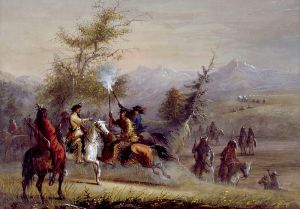
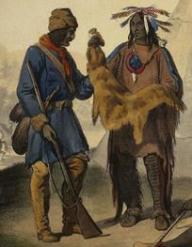
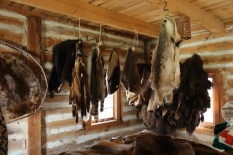
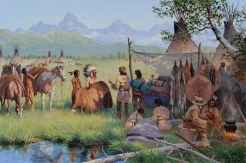
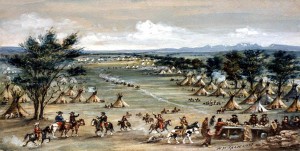 Large bands of Native Americans often gathered in the vicinity of Laketown. In 1870, a large community estimated at 3,000, camped on the south shore of Bear Lake. This caused the Mormon settlers a great deal of concern. After a meeting of the settlers and chiefs, among them Chief Washakie, an agreement was forged and the Native Americans moved to Wind River, Wyoming.
Large bands of Native Americans often gathered in the vicinity of Laketown. In 1870, a large community estimated at 3,000, camped on the south shore of Bear Lake. This caused the Mormon settlers a great deal of concern. After a meeting of the settlers and chiefs, among them Chief Washakie, an agreement was forged and the Native Americans moved to Wind River, Wyoming.